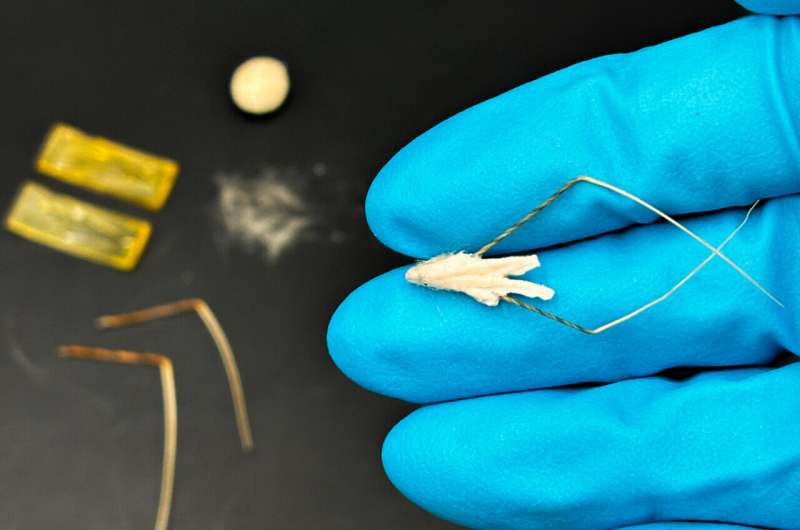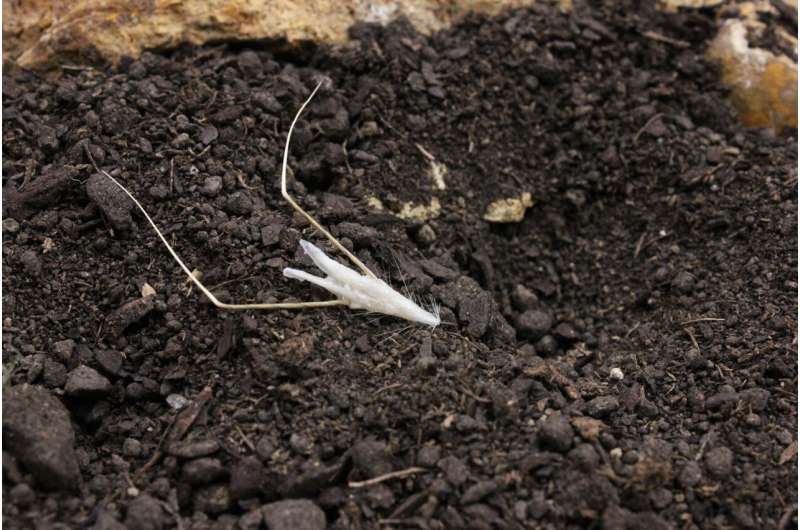This article has been reviewed according to Science X's editorial process and policies. Editors have highlighted the following attributes while ensuring the content's credibility:
fact-checked
trusted source
proofread
Biohybrid robot made from flour and oats could act as a biodegradable vector for reforestation

Researchers at Istituto Italiano di Tecnologia (IIT-Italian Institute of Technology) in collaboration with the University of Freiburg have developed a biohybrid robot, which consists of a flour-based capsule created using 3D microfabrication techniques, and two natural appendages from oat fruit capable of moving in response to air humidity.
Named HybriBot, this new device can accommodate natural seeds from different plants, serving as a biodegradable vector for reforestation. The research group has already conducted positive tests with tomato, chicory, and willow herb seeds, the latter being one of bees' favorite flowers, from which the plants germinated. A patent application has been filed for the invention.
HybriBot has been described in a paper published in Advanced Materials; it is born within the framework of the European project i-Seed coordinated by Barbara Mazzolai, Associate Director for Robotics at the IIT, and the innovation ecosystem RAISE (Robotics and AI for Socio-economic Empowerment).
The first author of the work is Isabella Fiorello, who after a research period at the IIT in Mazzolai's group, is now a Junior Principal Investigator at the Cluster of Excellence Living, Adaptive and Energy-autonomous Materials Systems (livMatS) at the University of Freiburg.
The invention represents a further solution that the Bioinspired Soft Robotics laboratory at the IIT, a pioneer in robotics inspired by living organisms, particularly plants, has identified to address problems related to climate change, such as the need for reforestation of large areas and the protection of biodiversity.
The artificial system HybriBot combines a natural component—the oat fruit appendices—with an artificial one, which acts as a transport vessel for seeds, maintaining the movement and interaction capabilities with the environment of the natural specimen.
The oat appendices react to the presence of moisture with movements. They rotate, intersect, and accumulate elastic energy, which, when released, moves the capsule. Their movements continue until, without any control, the plant creeps into a fissure in the ground where it stops, allowing the seed to germinate. HybriBot's movement, therefore, is not supported by batteries or other additional energy sources.

The artificial capsule weighs 60 mg, about 3 times the natural weight. It was created by studying the natural capsule and, then, by constructing a mold using 3D microfabrication techniques. The artificial body was made using flour, coated with ethyl cellulose to make the structure waterproof and stable. Once ready, the capsule can be filled with seeds of other plants and fertilizing substances.
The use of biodegradable materials of plant origin makes HybriBot a low environmental impact device; it is also harmless in the event that an animal might ingest it. The research group tested the effectiveness of seed deposition using various types of seeds, such as tomato, chicory, and willow herb, the latter being particularly useful in beekeeping; and in different types of soil, such as potting soil, clay, and sand.
More information: Isabella Fiorello et al, A Biohybrid Self‐Dispersing Miniature Machine Using Wild Oat Fruit Awns for Reforestation and Precision Agriculture, Advanced Materials (2024). DOI: 10.1002/adma.202313906
Provided by Italian Institute of Technology



















